Laurie Anne Walden, DVM Baby striped skunk. Photo by Kevin VanGorden, USDA Forest Service. Baby striped skunk. Photo by Kevin VanGorden, USDA Forest Service. Skunks aren’t aggressive, but they’ll spray dogs that get too close. Skunk spray is a smelly nuisance that doesn’t usually cause medical problems. However, it’s irritating to the eyes and in rare cases can cause more serious problems. Dogs are most likely to encounter skunks during warm months. In North Carolina, skunk breeding season is February through April; kits are born in May and June. Skunks live in cities like Charlotte, not just in rural areas. You might not see them often—or at all—because they’re most active at night. They live in wooded or brushy areas and raid garbage cans in residential neighborhoods. Skunk Spray Skunk spray is thick, oily material secreted from the anal glands. The nasty smell comes from thioacetates and thiols, chemical compounds that contain sulfur—the same element that makes rotten eggs so stinky. Thioacetates (the less smelly compounds) are converted to thiols (super smelly) when they’re exposed to water, and sulfur atoms tend to bind tightly to other atoms, so removing skunk odor from fur can be difficult. Because water activates the thiol conversion, a dog that’s been skunked can smell skunky after baths for a long time. Skunks can control their anal glands in ways that dogs and cats can’t. They can aim their anal gland spray at a target several feet away, or they can release a cloud of mist. Baby skunks can spray targets too. Risks to Dogs Spray Skunk spray in the eyes can cause redness, eyelid swelling, corneal damage, and temporary blindness. Inhaled skunk spray irritates the respiratory tract. The spray can also cause nausea and vomiting. Dogs sprayed by a skunk can develop life-threatening hemolytic anemia, although fortunately this is rare. The compounds in skunk spray can destroy red blood cells. The risk is likely highest for dogs that swallow the spray, dogs exposed to a large volume, and dogs with multiple exposures. Dogs with hemolytic anemia often need to be hospitalized at a 24-hour clinic and might need a blood transfusion. Bite Wounds and Rabies Skunks are a relatively common rabies carrier species in North Carolina. However, the chance that an individual skunk has rabies is low. Rabies is spread through saliva, not through skunk spray. Most dogs that encounter a skunk are sprayed before they get close enough to be bitten. Still, any dog that has been near a skunk should be checked carefully for bite wounds. Dogs with a bite wound need to see a veterinarian immediately for wound care and assessment of rabies risk. In North Carolina, dogs with a possible rabies exposure (for example, a bite wound from a rabies carrier species) need a rabies vaccine booster within 96 hours. What to Do if Your Dog Gets Skunked Most dogs sprayed by skunks don’t need to see a veterinarian. Monitor your dog for a few days and seek veterinary care if your dog has any of the following:
Deskunk your dog:
Prevention Keep your dog’s rabies vaccine up to date and make your yard unattractive to skunks:
For More Information
Image source: https://www.flickr.com/photos/lblkytn/14928066475/ Laurie Anne Walden, DVM Photo by Elisa Kennemer on Unsplash Photo by Elisa Kennemer on Unsplash Warm weather brings some extra risks for pets. Some animals need protection from sunlight, and all animals need protection from hot temperatures. Sun-Related Skin Conditions Ultraviolet (UV) radiation in sunlight causes skin damage in animals just like it does in humans. Fur and melanin (dark pigment) protect the skin from UV rays, so animals with short white hair or no hair are at higher risk than those with thick dark fur. Most animals with sun-related skin disease spend a lot of time outdoors, but even indoor cats can develop skin disease caused by UV rays coming through windows. Sun-related skin damage typically affects areas of the body that don’t have thick fur and are exposed to the sun. Any part of the body with thin or light-colored hair can be involved, but these are the most common areas:
Solar dermatitis, also called actinic dermatitis, is skin disease caused by exposure to UV radiation. It can be mistaken for allergic skin disease because the lesions are similar and it is often seasonal. Affected skin is red, painful to the touch, and scaly or flaky. Bumps and oozy lesions might develop. Over time, the skin becomes thickened and scarred. Because solar dermatitis usually causes a secondary skin infection, the lesions might improve with antibiotics, at least at first. UV radiation causes mutations within skin cells, so solar dermatitis can transform into skin cancer (squamous cell carcinoma or hemangiosarcoma, for example). These cancers are malignant: they can spread throughout the body. Solar dermatitis and skin cancer are diagnosed with skin biopsy. Heat Stroke Heat stroke is a life-threatening risk to animals during warm weather. Unlike solar dermatitis and skin cancer, it doesn’t require direct exposure to UV rays. The outdoor temperature doesn’t even have to be very hot for an animal to develop heat stroke. The temperature inside a parked car quickly rises higher than the outside temperature, so animals inside parked cars are at risk even in moderately warm weather. Brachycephalic (short-nosed) animals like pugs and bulldogs are at especially high risk. Signs of heat stroke include panting, dark red or purple gums, vomiting, collapse, and seizures. Heat stroke requires immediate first aid (cooling with water, not ice) and emergency veterinary care. For more information, see the blog post on heat stroke. How to Protect Your Pet The best way to protect animals is to minimize their exposure to UV rays and heat:
Sources
Image source: Elisa Kennemer on Unsplash Laurie Anne Walden, DVM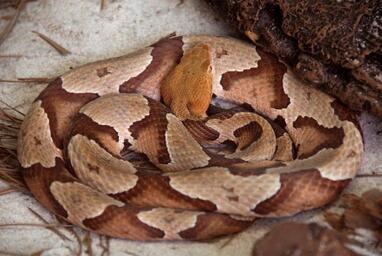 Adult southern copperhead. Photo credit: CDC/James Gathany. Adult southern copperhead. Photo credit: CDC/James Gathany. Spring is the start of snake season in North Carolina. The vast majority of snakes in our state are harmless. Only a few venomous snake species (copperheads, cottonmouths, rattlesnakes, and coral snakes) live in North Carolina. In the Charlotte-Mecklenburg area, the copperhead is by far the most common venomous snake. Learn to recognize copperheads. Copperheads have a distinctive hourglass pattern that from the side looks like a row of Hershey’s kisses. It’s easier to identify a copperhead by its markings than by the shape of its head or pupils. Head shape isn’t a reliable way to tell if a snake is venomous; some nonvenomous snakes can flatten their heads to mimic a pit viper’s triangular head. As for pupil shape (round vs vertical slits)—seriously, just don’t get close enough to a wild snake to check. You can see photos of North Carolina snakes on the Herps of NC website: https://herpsofnc.org/snakes/. You’ll notice that copperheads and also a lot of nonvenomous snakes are brown with splotches. This color combination is common because it’s great camouflage, but unfortunately it means that nonvenomous snakes are often mistaken for copperheads. Don’t worry too much about identifying a snake that’s bitten your dog. Treatment is based more on symptoms than on snake species, and it’s more important to get your dog to an emergency clinic without delay. If you want to identify a snake you’ve seen outdoors, take a photo so you can look it up online, but don’t approach or disturb the snake. Dogs get bitten because they’re curious, not because snakes are aggressive attack animals. Snakes hide in small spaces where they’re relatively safe from predators and can find food (mostly small rodents like mice). Woodpiles, tarps, underbrush, tall grass, leaf litter, rock crevices, and yard debris are all possible snake habitats. Snakes bite for defense. A dog that steps on a snake or sticks its nose into a snake’s hiding place can be bitten. Because of their color camouflage, copperheads are hard to spot. You and your dog might not even know a copperhead is there unless it bites one of you. Avoid snake areas. If you see a snake, leave it alone and walk away. Here are some ways to reduce your dog’s chance of a snake encounter:
If your dog is bitten, seek emergency veterinary care right away. Copperhead venom isn’t as toxic as cottonmouth or rattlesnake venom, but a copperhead bite can still be quite serious for a dog. Copperhead bites are very painful and cause swelling and tissue damage. The venom can also interfere with blood clotting. Dogs with snakebite are usually hospitalized for pain management, intravenous fluids, wound care, supportive care, and observation. Copperhead bites aren’t often treated with antivenin, but dogs with severe symptoms might need it. If your dog is bitten, stay calm and take your dog to an emergency clinic. Don’t use ice, a tourniquet, or anything to remove venom from the wound; all of these can make the tissue damage worse. Leave the snake alone. If you try to catch or kill it, you could be bitten too. CDC image source: https://phil.cdc.gov/Details.aspx?pid=10841 Laurie Anne Walden, DVM Yew is highly toxic to animals and people. Yew is highly toxic to animals and people. Some decorative winter holiday plants pose risks to pets. Other plants that aren’t actually toxic can still cause upset stomach if an animal swallows them. If you think your pet might have swallowed or been exposed to a toxic plant, contact your veterinarian, an animal emergency clinic, or a 24-hour animal poison control hotline (a fee may apply):
Amaryllis (Amaryllis species) Ingestion of amaryllis leaves, stems, or bulbs can cause drooling, vomiting, diarrhea, belly pain, lethargy, and a drop in blood pressure. Christmas cactus (Schlumbergera species) Christmas cactus isn’t toxic. However, an animal that swallows part of one might vomit or have diarrhea. Christmas rose, hellebore (Helleborus niger) Hellebores contain cardiac glycosides, compounds that affect heart function. Ingestion of any part of the plant can cause drooling, belly pain, vomiting, diarrhea, and lethargy. Christmas trees The Christmas trees most commonly grown in North Carolina (firs, pines, cedars, and cypress) aren’t toxic, although like other non-food plants they could cause vomiting or intestinal blockage if an animal swallowed enough of one. The risks to pets are from trees falling, ornaments breaking, exposure to electrical cords, and possibly exposure to preservatives (which are not very toxic but can cause mild vomiting, according to ASPCA Animal Poison Control). Norfolk Island pines and rosemary plants are often sold as potted miniature holiday trees. These two plants aren’t toxic to cats and dogs. However, a miniature tree made of mixed greenery would be a serious danger if it contained yew. Cyclamen (Cyclamen species) Ingestion of cyclamen, a flowering houseplant, can cause drooling, vomiting, and diarrhea. Swallowing a large amount of cyclamen tubers can lead to heart rhythm abnormalities, seizures, and death. Delphinium, larkspur (Delphinium species) Blue delphinium flowers are included in some Hanukkah floral arrangements. Toxic compounds in delphinium block a neurotransmitter that’s required for muscle function. Ingestion can cause digestive system problems (vomiting, diarrhea, or constipation), belly pain, drooling, weakness, abnormal heart rhythm, tremors, seizures, and paralysis. The most severe effects—heart or lung failure and death—are most likely to happen in grazing animals that ingest large amounts of the plant. Holly, winterberry, Christmas holly, English holly (Ilex aquifolium) Ingestion of English holly and similar plants in the genus Ilex can cause vomiting and diarrhea. The pointed leaves can injure the inside of the mouth, leading to drooling and other signs of mouth discomfort. Lily (Lilium species, Hemerocallis species) Lilies of various types are common in floral arrangements, including arrangements for winter holidays. Some lilies are so toxic to cats that they shouldn’t be brought at all into a house with cats. The most dangerous lilies are Lilium species (Easter lily, Japanese lily, Asiatic hybrid lilies, stargazer lily, Casablanca lily, and tiger lily) and Hemerocallis species (daylily). Ingestion of a tiny amount of plant material—even licking pollen from a paw—can cause kidney injury in cats. Calla lilies, peace lilies, lily of the valley, and Peruvian lilies are not Lilium and Hemerocallis species; these plants don’t damage the kidneys but can cause stomach upset and other problems. Mistletoe (Phoradendron species, Viscum album) Mistletoe ingestion can cause vomiting, diarrhea, and abdominal pain in animals. Swallowing large amounts can cause low heart rate, a drop in blood pressure, uncoordinated gait, and seizures. American mistletoe (Phoradendron species) is less toxic than European mistletoe (Viscum album). Paperwhite (Narcissus papyraceus) Paperwhites and other Narcissus species (like jonquils and daffodils) cause severe vomiting and diarrhea if ingested. Swallowing a large amount can lead to breathing and heart rhythm abnormalities. The most toxic part of the plant is the bulb. Poinsettia (Euphorbia pulcherrima) Poinsettias are not as toxic as some have been led to believe, according to ASPCA Animal Poison Control. The thick, milky sap is an irritant that can cause drooling and vomiting if ingested. The sap can also irritate the skin and eyes on contact. Yew (Taxus species) Plants in the genus Taxus are highly toxic to all animals, including dogs, cats, horses, and people. Yew branches and berries are sometimes used to make holiday wreaths and other decorations. Be very careful displaying and disposing of items that might contain yew; be sure pets and wildlife can’t access them. Yew ingestion causes vomiting, muscle tremors, difficulty breathing, heart failure, seizures, and death. Sources
Public domain photo of yew (Taxus baccata) by MM on Wikimedia Commons Laurie Anne Walden, DVM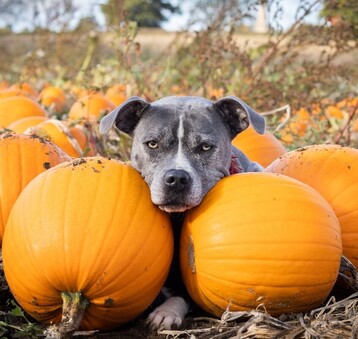 Photo by Amy Starr Photo by Amy Starr Dogs and cats can’t have pumpkin spice lattes or Halloween candy, but not all foods that we associate with fall are off the menu for our pets. If you’d like to give treats to your pets, keep these precautions in mind:
Homemade and store-bought pet treats Many recipes for homemade dog and cat treats are available. Making your own pet treats can be a fun family project and a great outlet for creativity. Kids might be surprised that their dog is so enthusiastic about a baked dog biscuit that tastes like cardboard to them. It’s a good reminder that pets don’t need the sugar, salt, and flavorings that humans prefer. Pet food manufacturers know a marketing opportunity when they see one, so you can also find themed seasonal treats for sale. Store-bought pet treats are fine as long as they don’t contain a problem ingredient (always check labels). Pumpkin Plain cooked or canned pumpkin is safe, and dogs and cats tend to like it. If you use canned pumpkin, be sure to get plain pumpkin and not pumpkin pie filling. The sugar and spices in pie filling can cause problems. Likewise, don’t give a pet a piece of pumpkin pie—and especially not sugar-free pie, which might contain xylitol. White potatoes and sweet potatoes Most dogs love potatoes of any type. Skip the butter, salt, and toppings, though: no loaded baked potatoes or sweet potato casserole for pets. Other vegetables and fruits Many vegetables and fruits (not grapes!) are safe, tasty, low-calorie treats for pets. As always, stick with plain, unseasoned items for animals. Avoid casseroles, which might contain problem ingredients like onion and fat. To avoid a choking risk, cut raw vegetables and fruits into small pieces and remove seeds, cores, and thick peels. These are some good options:
Turkey A bite of cooked lean poultry meat is safe for dogs and cats. Avoid giving pets skin, fat, bones, pan drippings, raw meat, or meat seasoned with onion. Popcorn Is popcorn a fall food? I think it depends on which Thanksgiving cartoons you watch. As with other foods, don’t add butter, salt, or seasonings to popcorn pieces you toss to your pets. Air-popped popcorn doesn’t have added fat, so it’s safer than oil-popped or microwaved popcorn for animals like schnauzers that have an increased risk for pancreatitis. Photo by Amy Starr on Unsplash Laurie Anne Walden, DVM Photo by Tyler Farmer Photo by Tyler Farmer Holiday celebrations can be stressful for pets. Visitors, changes in routine, changes in food, unfamiliar scents and objects in the home, traveling, and noise can all cause anxiety for animals. Animals are more likely to bite when they’re scared or anxious, so minimizing sources of stress for your pets will help keep the holidays happy for everyone. Limit Stressful Situations To identify sources of stress for your pets, think like an animal. Animals feel safest when their routines and environment are predictable. Keep meal times, nap times, and exercise and play schedules about the same as usual. You might want to sleep late on a holiday (OK, the day after a holiday), but if your pets are used to a very consistent morning routine, this change could contribute to stress. It’s normal and very human to want to include pets in our celebrations, but be careful not to think of your animals as little people in fur (or scale or feather) coats. They won’t feel left out if they’re not invited to a party. Most animals would rather be in a nice quiet room than in the middle of holiday hubbub. Think about your pets’ usual behavior around strangers and noise, and let them stay wherever they are most comfortable and safe. Be aware of foods that aren’t safe for animals, especially if you have visitors who don’t know what your pets should and shouldn’t eat. Chocolate, xylitol sweetener, grapes, raisins, onion, garlic, and raw yeast dough are some of the foods that can be dangerous for animals. Limit or avoid table food for your pets; fatty or rich food can cause digestive upset. A holiday trip to the emergency veterinary clinic is not on anyone’s wish list. Contact your veterinarian in advance if your pet is afraid of fireworks or has travel anxiety. Your veterinarian might recommend prescription or nonprescription antianxiety medication, depending on the symptoms. Plan ahead for this. Your pet might need a veterinary examination before medication can be prescribed. Watch for Signs of Stress The early signs of fear and anxiety can be subtle. Owners sometimes don’t realize their pets are in distress until the behavior escalates to aggression (an attempt to remove a perceived threat). Watch for any changes from the usual behavior. Some animals withdraw and hide in response to stress; others become hyperactive or clingy. Signs of Anxiety in Dogs
Signs of Anxiety in Cats
Photo by Tyler Farmer on Unsplash Laurie Anne Walden, DVM 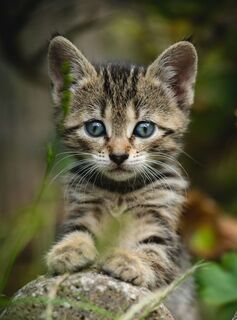 Some bugs carry dangerous diseases or have venomous stings. But what about insects that our pets catch and swallow? Most are harmless, but a few are unsafe for pets. As warm weather arrives, keep an eye out for insects that can cause trouble if they’re eaten. Pesticides and insecticides can also be toxic to pets. Keep these products out of your pets’ reach and use them only according to the manufacturer’s instructions. Dogs and cats are most likely to get a toxic dose if they’re sprayed with the product or eat a significant amount. A pet that eats a single pesticide-covered insect would ingest a little bit of the product, but the amount would probably be too small to cause a problem (call your veterinarian if you’re unsure or if your pet shows any symptoms). Caterpillars Caterpillar hairs can be irritating to the touch, and some types of hairs release a toxin. Fur typically protects dogs’ and cats’ skin from the stings of caterpillar hairs. If a pet eats a caterpillar, though, the hairs can irritate the mouth and throat. Symptoms include drooling, pawing at the mouth, shaking the head, vomiting, and trouble swallowing. Processionary caterpillars (found in Europe, North Africa, and Asia) produce a toxin that causes an especially severe reaction.[1,2] Fireflies Fireflies are highly toxic to lizards, amphibians, and birds. Ingestion of a single firefly can kill a bearded dragon. Fireflies contain lucibufagins, which are chemicals that cause heart damage in susceptible species.[3] Asian Lady Beetles Asian lady beetles (Harmonia axyridis) look a lot like ladybugs, but unlike ladybugs they gather in large numbers and come inside houses in cold weather. As a defense mechanism, they secrete an irritating chemical compound. One published report describes a dog with oral trauma similar to chemical burns caused by 16 Asian lady beetles stuck to the roof of the mouth.[4] Blister Beetles Blister beetles (family Meloidae) produce a toxin called cantharidin, an irritant that causes blistering on contact with the skin, mouth, or digestive tract. Cantharidin poisoning is most common in horses that eat alfalfa hay contaminated with blister beetles. Exposure can be fatal to horses. Other species, including dogs, cats, rabbits, and people, are also susceptible to cantharidin poisoning.[5] Walking Sticks The insects known as walking sticks (order Phasmatodea) use camouflage as their main defense mechanism, but some of them also secrete a chemical that can burn the eyes or mouth. Anisomorpha buprestoides, a stick insect found in the southern United States, can aim this secretion directly at the face of a predator. Severe eye damage has been reported in humans and a dog.[6] Bombardier Beetles Brachinus beetles are called bombardier beetles because they secrete a toxic chemical that they aim at predators in what is usually described as “explosive discharge.” This chemical irritant is released at a boiling temperature.[7] Although I did not find any research reports of bombardier beetle poisoning in dogs or cats, I can’t imagine that eating one would be a comfortable experience. References 1. Bad bugs, bad bugs: what you should do to keep your pets safe. ASPCA. August 1, 2018. Accessed March 5, 2021. https://www.aspca.org/news/bad-bugs-bad-bugs-what-you-should-do-keep-your-pets-safe 2. Fuzzy green poisoners: caterpillar toxicosis in pets. ASPCA Pro. Accessed March 5, 2021. https://www.aspcapro.org/resource/fuzzy-green-poisoners-caterpillar-toxicosis-pets 3. Treating firefly toxicosis in lizards. ASPCA Pro. Accessed March 5, 2021. https://www.aspcapro.org/resource/treating-firefly-toxicosis-lizards 4. Stocks IC, Lindsey DE. Acute corrosion of the oral mucosa in a dog due to ingestion of multicolored Asian lady beetles (Harmonia axyridis: Coccinellidae). Toxicon. 2008;52(2):389-391. doi:10.1016/j.toxicon.2008.05.010 5. Schmitz DG. Overview of cantharidin poisoning. Merck Veterinary Manual. Updated June 2013. Accessed March 5, 2021. https://www.merckvetmanual.com/toxicology/cantharidin-poisoning/overview-of-cantharidin-poisoning 6. Thomas MC. Featured creatures: twostriped walkingstick. University of Florida Entomology & Nematology. Publication No. EENY-314. November 2003. Accessed March 5, 2021. http://entnemdept.ufl.edu/creatures/misc/walkingstick.htm 7. Schaller JC, Davidowitz G, Papaj DR, Smith RL, Carrière Y, Moore W. Molecular phylogeny, ecology and multispecies aggregation behaviour of bombardier beetles in Arizona. PLoS One. 2018;13(10):e0205192. doi:10.1371/journal.pone.0205192 Photo by Kazuky Akayashi Laurie Anne Walden, DVM 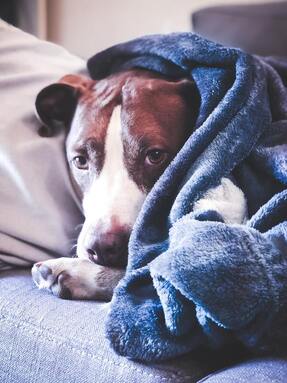 Many over-the-counter (nonprescription) cold and flu medications contain ingredients that are toxic to dogs and cats. Keep all medications out of reach of your pets, and check with your veterinarian before giving a pet any medication—even remedies that are safe for children. Cold medications are often sold as combination or multisymptom products containing more than 1 active ingredient. If your veterinarian recommends giving your pet a nonprescription medication, read the product label carefully to be sure it contains only the medication your veterinarian has approved. Ingestion of some cold and flu products (especially oral decongestants, nasal sprays, eye drops, and pain relievers) is a medical emergency in animals. If your pet is exposed, contact a veterinary clinic or pet poison hotline:
Oral Decongestants Decongestants are often added to allergy medications and combination cold and cough remedies. If your veterinarian has recommended a nonprescription antihistamine for your pet, be sure that the product you use does not contain a decongestant. Look for label wording like congestion, stuffy nose, runny nose, multisymptom, or sinus pressure; these probably mean that the product includes a decongestant. Names of products containing decongestants might end in D (for example, Claritin-D and Mucinex D) or PE (as in Sudafed PE). Pseudoephedrine and phenylephrine are the most common oral (by-mouth) decongestants. Both are dangerous for animals. In the United States, pseudoephedrine is sold without a prescription but with restrictions: it’s sold only in limited quantities, is usually kept behind the pharmacy counter or in a locked cabinet, and requires that the buyer show identification. If you’re not sure of the ingredients of your cold medication, knowing whether you took it from an open shelf or had to ask the pharmacist for it will help you figure out whether it is likely to contain pseudoephedrine. Pseudoephedrine stimulates the cardiovascular system and certain nervous system pathways. It reduces nasal congestion by shrinking tiny blood vessels in the nose. It has a very narrow margin of safety in animals, meaning that a small dose can have serious consequences for a dog or cat. Symptoms of pseudoephedrine toxicity include the following:
The time of symptom onset depends on the formulation. With immediate-release products, symptoms can begin within minutes of ingestion. With extended-release products, symptoms might not appear for several hours.[1] Phenylephrine is an ingredient in oral cold remedies, hemorrhoid creams, nasal sprays, and some eye drops. Animals are exposed by swallowing the product. The most common symptom is vomiting; other symptoms are similar to those of pseudoephedrine toxicity. Phenylephrine is not as toxic as pseudoephedrine at low doses.[2] Nasal Sprays and Eye Drops Oxymetazoline, tetrahydrozoline, naphazoline, and xylometazoline are imidazolines, a class of decongestant used in nasal sprays and eye drops (examples are Afrin and Visine). Animals—usually dogs—who chew the bottle and ingest the liquid can develop vomiting, lethargy, incoordination, slow heart rate, tremors, and coma. Imidazoline ingestion can be fatal.[3] Some nasal sprays contain xylitol, a sweetener that is safe for humans but toxic to pets. Plain saline nasal rinses with no ingredients other than water and salt should be safe if accidentally ingested, but don’t squirt them up your pet’s nose. Pain Relievers Combination cold and flu products commonly contain pain relievers, most of which are unsafe for dogs and cats. Acetaminophen is extremely toxic to cats even at low doses. It causes liver failure, damage to hemoglobin in red blood cells, and death. It can also cause liver damage in dogs. Ibuprofen and naproxen are in a class of pain relievers called nonsteroidal anti-inflammatory drugs. In dogs and cats, these medications can cause stomach ulcers, digestive tract bleeding, kidney damage, and liver damage. Cough Suppressants and Cough Drops Dextromethorphan is an antitussive, or cough suppressant, included in many cough remedies and combination cold and flu products. Animals who ingest dextromethorphan can develop vomiting, lethargy, rapid heart rate, and seizures.[4] Potentially toxic ingredients in cough drops include xylitol, which causes a dangerous drop in blood sugar in dogs, and benzocaine, which can cause upset stomach and possibly damage to red blood cells. “Natural” Remedies In high enough doses, zinc can damage red blood cells. Essential oils like menthol, camphor, and eucalyptus oil can cause skin reactions if applied topically. If swallowed or absorbed through the skin, these oils can cause symptoms ranging from vomiting to nervous system problems. References 1. Pseudoephedrine toxicity in pets. ASPCApro. Accessed January 9, 2021. https://www.aspcapro.org/resource/pseudoephedrine-toxicity-pets 2. Wegenast C. Toxicology brief: phenylephrine ingestion in dogs: what's the harm? DVM360. November 1, 2012. Accessed January 9, 2021. https://www.dvm360.com/view/toxicology-brief-phenylephrine-ingestion-dogs-whats-harm 3. Imidazoline. Pet Poison Helpline. Accessed January 9, 2021. https://www.petpoisonhelpline.com/poison/imidazoline/ 4. Dextromethorphan ingestion in pets. ASPCApro. Accessed January 9, 2021. https://www.aspcapro.org/resource/dextromethorphan-ingestion-pets Photo by Shlomi Platzman Laurie Anne Walden, DVM  Pancreatitis, or inflammation of the pancreas, is common in dogs and cats. Although some cases are relatively mild, pancreatitis is painful and can cause severe disease and even death. Pancreatitis can be triggered by eating a high-fat meal or table scraps, so be very cautious about sharing holiday food with your pets. Pancreatitis is categorized as acute (a short course of disease that can be reversed) or chronic (long-term disease caused by permanent damage to pancreatic cells). These categories can overlap. Animals with repeated episodes of acute pancreatitis can develop chronic pancreatitis, and animals with chronic pancreatitis can have flares of acute disease. In cats, the chronic form is more common than the acute form.[1] The pancreas, which is located near the stomach and small intestine, produces digestive enzymes and insulin. Because of the anatomic location and functions of the pancreas, pancreatic disease doesn’t always happen in isolation. Diseases of the liver, bile duct, and small intestine affect the pancreas and vice versa. In cats, simultaneous inflammation of the liver, small intestine, and pancreas is called triaditis.[2] Chronic pancreatitis is associated with diabetes mellitus and deficiency of digestive enzymes. Causes The cause of pancreatitis in dogs and cats is often not found. However, some risk factors make pancreatitis more likely:
Symptoms The symptoms of pancreatitis vary according to disease severity and are not specific; many disorders can cause the same symptoms. Symptoms are usually more severe with acute pancreatitis than with chronic pancreatitis. Other disorders that accompany pancreatitis also contribute to the symptoms. These are some of the symptoms of acute pancreatitis:
The symptoms of chronic pancreatitis are often vague and can be mistaken for other disorders. Animals with chronic pancreatitis might have these symptoms:
Diagnosis Diagnosing pancreatitis can be tricky, especially in animals with vague symptoms or multiple organ systems affected. Baseline bloodwork and urinalysis don’t necessarily give a diagnosis but help assess the patient’s overall health and reveal associated disorders. A diagnosis of pancreatitis is typically made with a combination of blood tests for pancreas-specific factors (like serum amylase, serum lipase, canine and feline pancreas-specific lipase, pancreatic lipase immunoreactivity, and trypsin-like immunoreactivity) and ultrasonography of the abdomen.[4] Treatment Animals with acute pancreatitis usually need to stay in the hospital for at least a few days. Treatment can include intravenous fluids, pain management, antiemetics to control vomiting, tube feeding, possibly antibiotics, treatment of the underlying cause (if known), and treatment of associated disorders. Patients are monitored closely for complications like organ failure and blood clotting disorders. Animals with recurrent acute pancreatitis, chronic pancreatitis, or triaditis might need long-term diet modification.[2,5] Prognosis The prognosis depends on disease severity. Patients with mild disease tend to recover well, but the prognosis is guarded for animals with severe pancreatitis. References 1. Watson P. Pancreatitis in dogs and cats: definitions and pathophysiology. J Small Anim Pract. 2015;56(1):3-12. doi:10.1111/jsap.12293 2. Simpson KW. Pancreatitis and triaditis in cats: causes and treatment. J Small Anim Pract. 2015;56(1):40-49. doi:10.1111/jsap.12313 3. Lem KY, Fosgate GT, Norby B, Steiner JM. Associations between dietary factors and pancreatitis in dogs. J Am Vet Med Assoc. 2008;233(9):1425-1431. doi:10.2460/javma.233.9.1425 4. Xenoulis PG. Diagnosis of pancreatitis in dogs and cats. J Small Anim Pract. 2015;56(1):13-26. doi:10.1111/jsap.12274 5. Steiner JM. Pancreatitis in dogs and cats. Merck Veterinary Manual. Updated October 2020. Accessed December 22, 2020. https://www.merckvetmanual.com/digestive-system/the-exocrine-pancreas/pancreatitis-in-dogs-and-cats Photo by Sebastian Coman Travel Laurie Anne Walden, DVM 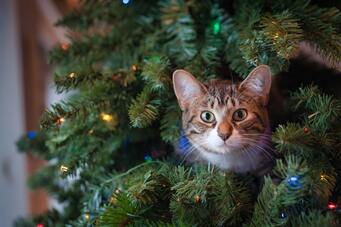 Happy holidays! Keep your cat safe from these common household dangers when you’re preparing for the season. Strings Ribbons, tinsel, yarn, twine, fishing line, thread, garland, and other long strings are hazardous if swallowed. A string in the digestive tract can cause a linear foreign body obstruction. Cats with digestive tract obstruction need surgery to prevent serious damage to the intestines. Keep this danger in mind when choosing holiday decorations. Wide ribbons might be less of a swallowing hazard than narrow ribbons. Shiny Objects Tinsel is especially attractive to cats because it’s sparkly, so a long string of tinsel is an intestinal obstruction waiting to happen. Watch out for glass ornaments that can cut paws if they mysteriously land on the floor and break. Expect that your cats will treat all glittery and shiny items as cat toys and decorate accordingly. Wood and fabric ornaments are safer than glass ornaments in a household with cats. The Tree With Christmas trees, the goal is to prevent damage to your cat and damage to property. Christmas tree dangers to cats include tree water (might contain preservatives or pesticides), swallowed pine needles, broken or swallowed ornaments, electrical wires, and being hit by a falling tree. If your cat ignores the tree, you might not need to do anything more than keep breakable ornaments on high branches, cat-safe (or no) ornaments on low branches, and a close eye on your cat when he’s in the room with the tree. But if your cat is young, curious, adventurous, or new to your home, assume he’ll want to climb the Christmas tree. The safest approach is to either not have a tree or to close the door and keep the cat out of the room. If your cat has access to the tree, use a sturdy base and secure the tree to the ceiling or walls so it can’t tip over. Don’t use any breakable ornaments if your cat is a climber. To prevent electrocution, keep the tree lights unplugged when you’re not watching your cat. Try giving your cat a more attractive alternative, like a high perch and new toys or a cat Christmas tree (maybe made from a cardboard box). You could try bitter orange spray or an unappealing floor covering around the tree (aluminum foil, adhesive paper with the sticky side up, or a nonslip rug gripper with the pointy side up), but don’t count on deterrents like these to keep your cat out of the tree. Other Plants Lilies are among the most dangerous plants for cats; don’t bring them in your house at all if you have a cat. Holly, mistletoe, and amaryllis are toxic to cats to some degree. Poinsettias are mildly toxic to cats. Flames and Electrical Wires Cats like to push things off tables and are curious about new items in their living space. Don’t leave a cat alone with lit candles, which are a fire hazard if knocked over. Cats will also chew on electrical cords, so cover the cords and keep lights and other electrical decor unplugged when not in use. Human Food Onions, leeks, chives, and garlic are toxic to cats. Chocolate, alcohol, raw bread dough, fatty food, raw eggs, raw meat, and bones are also dangerous for cats. See the blog post on human foods that are toxic to pets for more information. If you’d like to share some of your holiday meal with your cat, see the post on Thanksgiving foods that are safe for dogs and cats. Photo by Jessica Lewis |
AuthorLaurie Anne Walden, DVM Categories
All
Archives
June 2024
The contents of this blog are for information only and should not substitute for advice from a veterinarian who has examined the animal. All blog content is copyrighted by Mallard Creek Animal Hospital and may not be copied, reproduced, transmitted, or distributed without permission.
|
- Home
- About
- Our Services
- Our Team
-
Client Education Center
- AKC: Spaying and Neutering your Puppy
- Animal Poison Control
- ASPCA Poisonous Plants
- AVMA: Spaying and Neutering your pet
- Biting Puppies
- Boarding Your Dog
- Caring for the Senior Cat
- Cats and Claws
- FDA warning - Bone treats
- Force Free Alliance of Charlotte Trainers
- Getting your Cat to the Vet - AAFP
- Holiday Hazards
- How To Feed Cats for Good Health
- How to Get the Most Out of your Annual Exam
- Indoor Cat Initiative - OSU
- Introducing Your Dog to Your Baby
- Moving Your Cat to a New Home
- Muzzle Training
- Osteoarthritis Checklist for Cats
- What To Do When You Find a Stray
- Our Online Store
- Dr. Walden's Blog
- Client Center
- Contact
- Cat Enrichment Month 2024
|
Office Hours
Monday through Friday 7:30 am to 6:00 pm
|
Mallard Creek Animal Hospital
2110 Ben Craig Dr. Suite 100
|
Site powered by Weebly. Managed by IDEXX Laboratories

 RSS Feed
RSS Feed